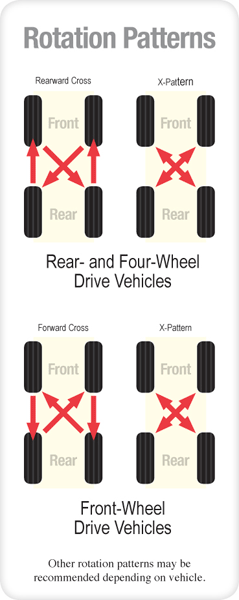Tire rotation refers to the movement of tires to different positions on the vehicle. This is done to equalize tread wear of your tires, and should be part of your vehicle regular maintenance schedule. Because each tire on your car supports a different amount of weight, your tires can wear at different rates. By rotating your tires, you can extend their useful life.
Benefits of Regular Tire Rotation:
- Longer tire life.
- Promotes uniform tire wear.
- Better gas mileage.
- Assures warranty compliance (with alignments)*
When you purchase your tires from Dunn Tire, our Out-The-Door Pricing includes FREE Lifetime Tire Rotations. This will save you hundreds of dollars over the life of your tires.
The interval most vehicle and tire makers recommend is every 5,000 to 8,000 miles, and even more frequently if you have a Front-Wheel Drive, All-Wheel Drive or 4-Wheel drive vehicle. An easy interval to remember is to have your tires rotated every other oil change.
If your tires show signs of irregular or uneven tread wear, bring your vehicle to any Dunn Tire location to have one of our service technicians locate the cause of the wear problem.
Keep in mind that sometimes the front and rear tires on a vehicle may use different pressures. After a rotation is performed, we will adjust the individual pressure to the figures recommended by the vehicle manufacturer (based upon each tires new position on the vehicle).
Sample Rotation Patterns

NOTE: Do not include a "Temporary Use Only" spare tire in any of the rotation patterns shown. If you have a matching full-size tire as a spare and wish to include it in the rotation process, use one of the patterns shown. Insert the spare in the right rear position and place the tire that would have gone on the right rear in the trunk as the new spare.
Some tires cannot be rotated in the manners described including uni-directional tires and tires with asymmetric tread designs. Also, some vehicles may have different-sized tires mounted on the front and rear axles, and these different-sized tires also have rotation restrictions. Check your owner's manual for the proper rotation recommendations for these special cases.
*Consult your tire maintenance and warranty manual for complete details.
